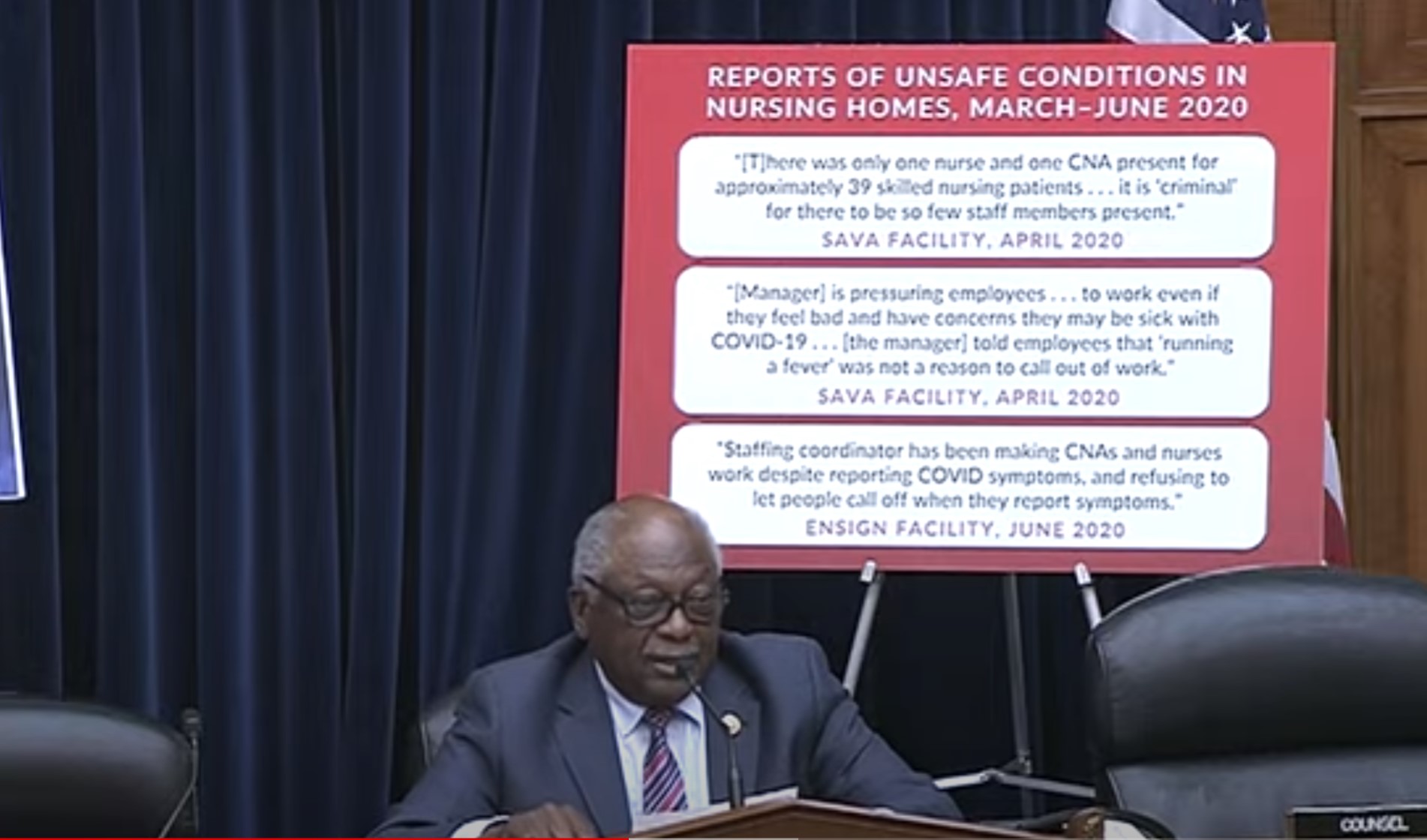Chairman Clyburn’s Opening Statement at Hearing on “Examining Long-Term Care in America: The Impact of the Coronavirus in Nursing Homes"
Washington, D.C. (September 21, 2022) – Below is Select Subcommittee on the Coronavirus Crisis Chairman James E. Clyburn's opening statement, as delivered, for a hearing on "Examining Long-Term Care in America: The Impact of the Coronavirus in Nursing Homes" with nursing home experts, a frontline worker, and a resident advocate.

Click here to watch
Opening Statement
Chairman James E. Clyburn
Select Subcommittee on the Coronavirus Crisis
Hearing on "Examining Long-Term Care in America: The Impact of the Coronavirus in Nursing Homes"
September 21, 2022
Few places have felt the devastating effects of the coronavirus crisis more deeply than America's nursing homes. More than 200,000 Americans living in nursing homes and other long-term care facilities have died from the coronavirus, representing 20 percent of all coronavirus deaths in our nation.
The outsized risks to nursing home residents and workers became evident in the earliest days of the crisis. The first major coronavirus outbreak in the United States occurred at the Life Care Center of Kirkland, Washington, in February 2020, where the virus infected more than two-thirds of the facility's residents and dozens of staff, resulting in loss of nearly 40 lives.
The ferocity with which the coronavirus swept through our nation's nursing homes in 2020 exposed vulnerabilities that had been building for years. Far too many nursing homes had inadequate staffing and poor infection control practices well before the pandemic. These longstanding problems helped to drive outbreaks and exacerbated risks for Americans who need long-term care.
Compounding these problems, Americans at greatest risk were left behind by our leaders when the virus hit our shores.The Trump Administration's failure to heed early warnings left nursing home workers and residents ill-prepared. They refused to take steps necessary to curtail the spread of the virus before vaccines were developed, leaving nursing homes without testing and personal protective equipment necessary to detect and prevent outbreaks.
New documents obtained by the Select Subcommittee and released today paint a devastating picture of conditions inside large, for-profit nursing homes across the country during these crucial early months of the pandemic.
In reports to hotlines run by nursing home chains, residents, their loved ones, and staff members described the dire conditions they were experiencing during that terrible time.
At one facility in Texas, a caller reported that employees were forced to make isolation gowns out of disposable bags that were, quote, "stapled and taped together." At another home in the Midwest, a caller stated that employees had to wear the same disposable mask for seven days in a row.
Examples of the reports we received are illustrated here. I think you should be able to see this.
Multiple reports from facilities around the country described severe staff shortages, with one family member commenting that it's, and this is a quote, "criminal for there to be so few staff members present."
These new documents also shed light on the pressure placed on nursing home staff. An employee at a Maryland facility who was experiencing coronavirus symptoms was reportedly told that they would be fired if they did not come to work. At another nursing home in Colorado, a manager pressured employees to come to work, "even if they feel bad and have concerns they may be sick with COVID-19."
Fortunately, our nation has come a long way since these dark days. Lifesaving vaccines and treatments have helped to save countless lives among nursing home residents and staff.
The Biden-Harris Administration has prioritized protecting the health of Americans in long-term care facilities. In addition to conducting an historic vaccination campaign and dramatically increasing the supply of tests and PPE, the Administration has sought to institute important reforms, such as minimum staffing requirements and measures to reduce crowding inside nursing homes.
While the heightened risks that existed in 2020 have passed, risks to nursing home residents and staff still remain. We must take further steps to address longstanding challenges in this industry. We must increase the uptake of boosters among residents and staff to make sure that they stay protected against new coronavirus variants. We must ensure that nursing home workers receive adequate pay and benefits—such as paid sick leave—which is crucial for the health and safety of residents as it is for staff. We must also improve oversight and transparency in the nursing home industry to give residents and their loved ones the ability to make informed decisions about their care.
I would like to thank all our witnesses for testifying today. I look forward to hearing more about the challenges facing our nation's nursing homes and the changes that are needed to fix these longstanding problems so that our nation's nursing homes are safe places for those who need care.